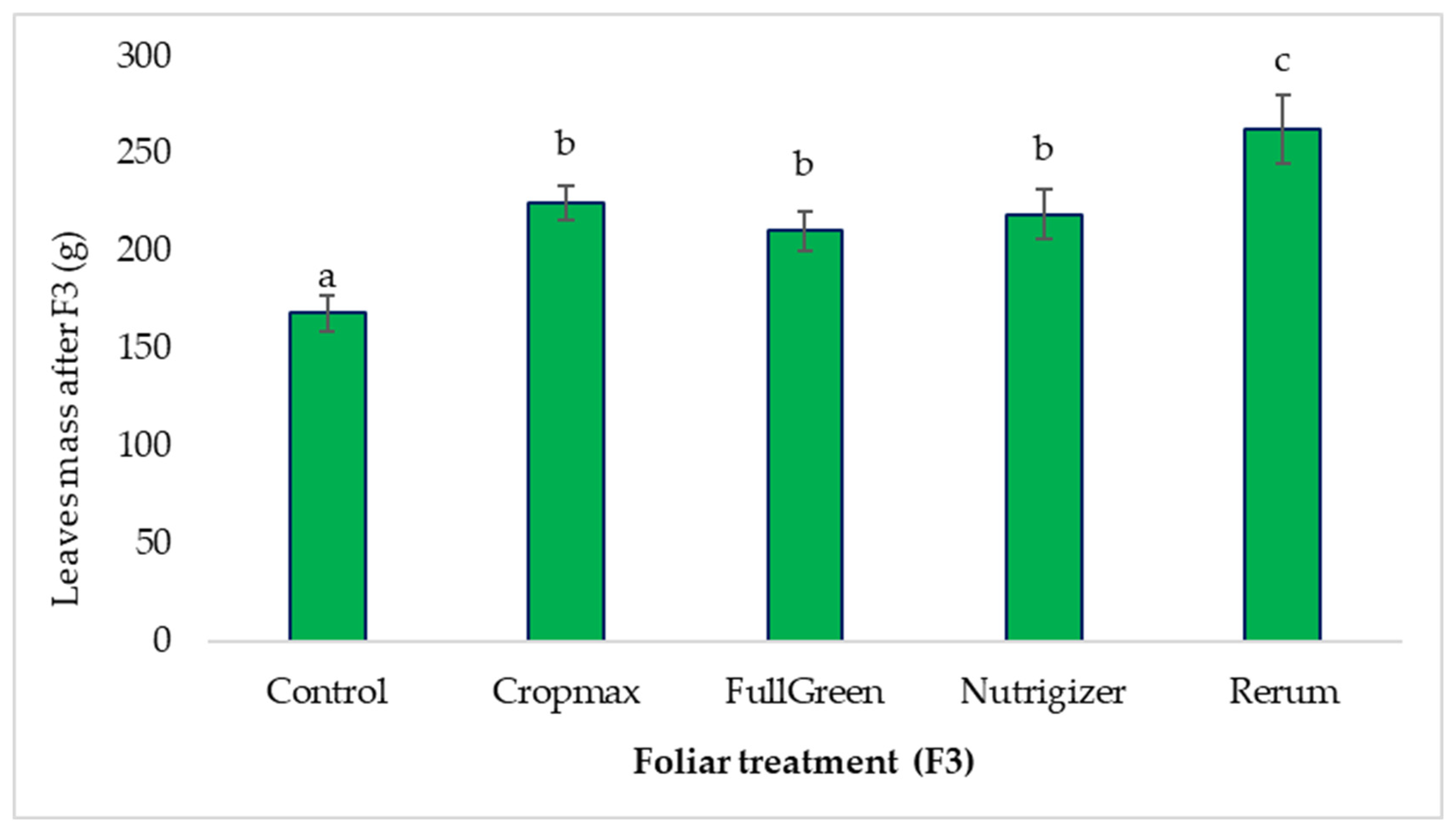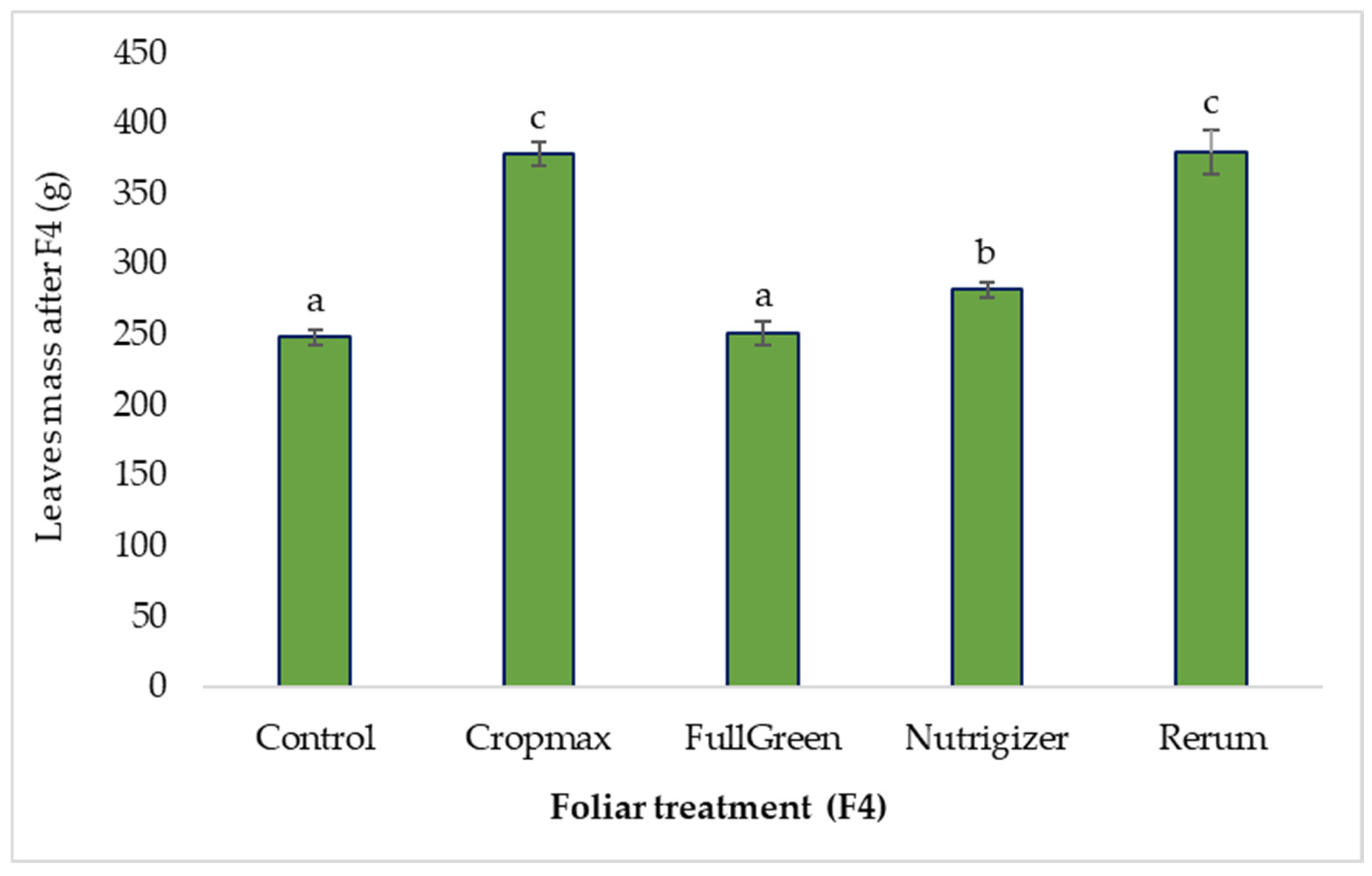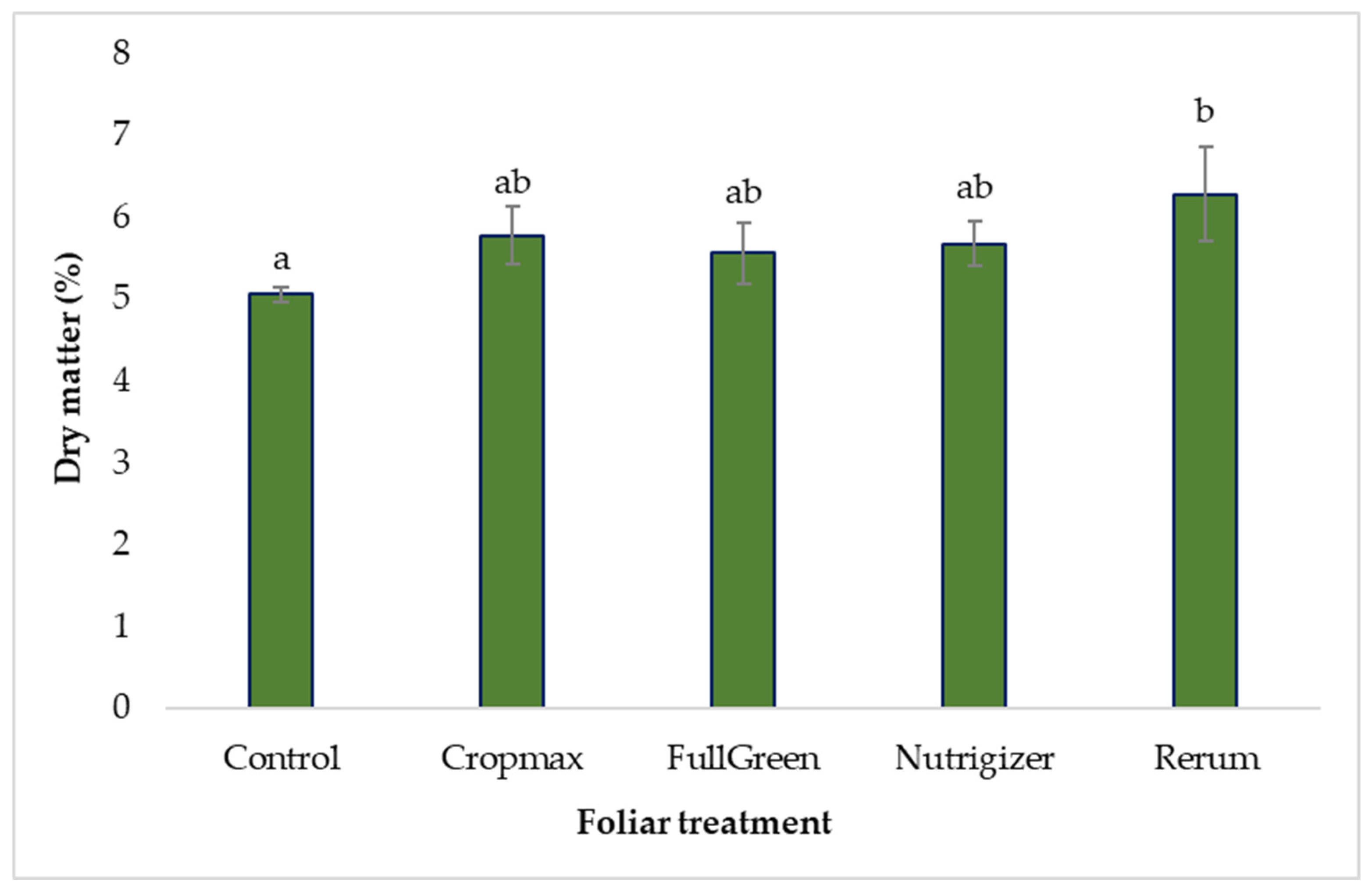A Sustainable Technology Approach to Lettuce (Lactuca sativa L.) Grown Under Greenhouse Condition Through Foliar Application of Various Biostimulants
Abstract
1. Introduction
2. Material and Methods
2.1. Soil Analyses
2.2. Plant Material
2.3. Inputs Used in the Experiment
2.4. Experimental Design
2.5. Fertilization Protocol
2.6. Plant Analyses
2.7. Statistical Processing of the Data
3. Results and Discussion
3.1. Impact of Foliar Treatments on the Average Leaf Mass After Fertilization Treatments
3.1.1. The Influence of Foliar Treatments on the Average Leaf Mass After the First Fertilization (F1)
3.1.2. The Influence of Foliar Treatments on the Average Leaf Mass After the Second Fertilization (F2)
3.1.3. The Influence of Foliar Treatments on the Average Leaf Mass After the Third Fertilization (F3)
3.1.4. The Influence of Foliar Treatments on the Average Leaf Mass After the Fourth Fertilization (F4)
3.2. Results on Lettuce Yield Under the Influence of Applied Foliar Treatments
3.3. Results on the Variability in Quality Indices Under the Influence of Applied Foliar Treatments
3.3.1. Variability in Dry Matter Content
3.3.2. Variability in Ascorbic Acid Content
3.3.3. Variability in Sugar Content
3.4. Analysis of Data Variability Through Principal Component Analysis (PCA)
3.5. Comparative Analysis of Biostimulants’ Effects on Lettuce
4. Conclusions and Future Perspectives
Supplementary Materials
Author Contributions
Funding
Institutional Review Board Statement
Informed Consent Statement
Data Availability Statement
Conflicts of Interest
References
- Torres, J.D.; Jaeger, S.; Puerta, P.; Tarrega, A. How do Spanish consumers perceive different lettuce cultivation systems? Insights from explicit and implicit methods. Appl. Food Res. 2025, 5, 100709. [Google Scholar] [CrossRef]
- Petropoulou, A.S.; van Marrewijk, B.; de Zwart, F.; Elings, A.; Bijlaard, M.; van Daalen, T.; Jansen, G.; Hemming, S. Lettuce Production in Intelligent Greenhouses—3D Imaging and Computer Vision for Plant Spacing Decisions. Sensors 2023, 23, 2929. [Google Scholar] [CrossRef] [PubMed]
- Baslam, M.; Garmendia, I.; Goicoechea, N. Enhanced Accumulation of Vitamins, Nutraceuticals and Minerals in Lettuces Associated with Arbuscular Mycorrhizal Fungi (AMF): A Question of Interest for Both Vegetables and Humans. Agriculture 2013, 3, 188–209. [Google Scholar] [CrossRef]
- Shi, M.; Gu, J.; Wu, H.; Rauf, A.; Emran, T.B.; Khan, Z.; Mitra, S.; Aljohani, A.S.M.; Alhumaydhi, F.A.; Al-Awthan, Y.S.; et al. Phytochemicals, Nutrition, Metabolism, Bioavailability, and Health Benefits in Lettuce—A Comprehensive Review. Antioxidants 2022, 11, 1158. [Google Scholar] [CrossRef]
- Volpe, M.L.; Vargas, V.C.S.; Morón, A.; González, R.E. Bioactive Compounds, Antioxidant Activity and Growth Behavior in Lettuce Cultivars Grown under Field and Greenhouse Conditions. Proceedings 2021, 70, 52. [Google Scholar] [CrossRef]
- Cho, E.; Gurdon, C.; Zhao, R.; Peng, H.; Poulev, A.; Raskin, I.; Simko, I. Phytochemical and Agronomic Characterization of High-Flavonoid Lettuce Lines Grown under Field Conditions. Plants 2023, 12, 3467. [Google Scholar] [CrossRef]
- Tokarz, B.; Gajewski, Z.; Makowski, W.; Mazur, S.; Kiełkowska, A.; Kunicki, E.; Jeremiasz, O.; Szendera, W.; Wesołowski, W.; Tokarz, K.M. The Effect of Head Lettuce (Lactuca sativa var. capitata L.) Cultivation Under Glass with a Light Spectrum-Modifying Luminophore on Crop Traits. Agronomy 2025, 15, 2090. [Google Scholar] [CrossRef]
- Hong, J.; Xu, F.; Chen, G.; Huang, X.; Wang, S.; Du, L.; Ding, G. Evaluation of the Effects of Nitrogen, Phosphorus, and Potassium Applications on the Growth, Yield, and Quality of Lettuce (Lactuca sativa L.). Agronomy 2022, 12, 2477. [Google Scholar] [CrossRef]
- Luetic, S.; Knezovic, Z.; Jurcic, K.; Majic, Z.; Tripkovic, K.; Sutlovic, D. Leafy Vegetable Nitrite and Nitrate Content: Potential Health Effects. Foods 2023, 12, 1655. [Google Scholar] [CrossRef]
- Acin-Albiac, M.; García-Jiménez, B.; Marín Garrido, C.; Borda Casas, E.; Velasco-Alvarez, J.; Serra, N.S.; Acedo, A. Lettuce Soil Microbiome Modulated by an L-α-Amino Acid-Based Biostimulant. Agriculture 2023, 13, 344. [Google Scholar] [CrossRef]
- Mesmar, A.K.; Albedwawi, S.T.; Alsalami, A.K.; Alshemeili, A.R.; Abu-Elsaoud, A.M.; El-Tarabily, K.A.; Al Raish, S.M. The Effect of Recycled Spent Coffee Grounds Fertilizer, Vermicompost, and Chemical Fertilizers on the Growth and Soil Quality of Red Radish (Raphanus sativus) in the United Arab Emirates: A Sustainability Perspective. Foods 2024, 13, 1997. [Google Scholar] [CrossRef] [PubMed]
- Sible, C.N.; Seebauer, J.R.; Below, F.E. Plant Biostimulants: A Categorical Review, Their Implications for Row Crop Production, and Relation to Soil Health Indicators. Agronomy 2021, 11, 1297. [Google Scholar] [CrossRef]
- Li, J.; Van Gerrewey, T.; Geelen, D. A Meta-Analysis of Biostimulant Yield Effectiveness in Field Trials. Front. Plant Sci. 2022, 13, 836702. [Google Scholar] [CrossRef] [PubMed]
- Szparaga, A.; Kuboń, M.; Kocira, S.; Czerwińska, E.; Pawłowska, A.; Hara, P.; Kobus, Z.; Kwaśniewski, D. Towards Sustainable Agriculture—Agronomic and Economic Effects of Biostimulant Use in Common Bean Cultivation. Sustainability 2019, 11, 4575. [Google Scholar] [CrossRef]
- Rajabi Hamedani, S.; Rouphael, Y.; Colla, G.; Colantoni, A.; Cardarelli, M. Biostimulants as a Tool for Improving Environmental Sustainability of Greenhouse Vegetable Crops. Sustainability 2020, 12, 5101. [Google Scholar] [CrossRef]
- Ginter, A.; Zarzecka, K.; Gugała, M. Effect of Herbicide and Biostimulants on Production and Economic Results of Edible Potato. Agronomy 2022, 12, 1409. [Google Scholar] [CrossRef]
- Cristofano, F.; El-Nakhel, C.; Rouphael, Y. Biostimulant Substances for Sustainable Agriculture: Origin, Operating Mechanisms and Effects on Cucurbits, Leafy Greens, and Nightshade Vegetables Species. Biomolecules 2021, 11, 1103. [Google Scholar] [CrossRef]
- Chaski, C.; Petropoulos, S.A. The Alleviation Effects of Biostimulants Application on Lettuce Plants Grown under Deficit Irrigation. Horticulturae 2022, 8, 1089. [Google Scholar] [CrossRef]
- Mezeyová, I.; Kollárová, I.; Golian, M.; Árvay, J.; Mezey, J.; Šlosár, M.; Galovičová, L.; Rosa, R.; Bakalár, M.; Horečná, T. The Effect of Humic-Based Biostimulants on the Yield and Quality Parameters of Chili Peppers. Horticulturae 2024, 10, 998. [Google Scholar] [CrossRef]
- Oliveira, T.M.L.d.; Pires, J.S.B.; Oliveira, V.d.S.; Jeveaux Machado, A.J.C.; Fernandes, A.A.; Arantes, L.d.O.; Dousseau-Arantes, S. Potential of the Use of Biostimulants in Lettuce Production. Plants 2025, 14, 2416. [Google Scholar] [CrossRef]
- Fragalà, F.; Salvagno, E.; La Bella, E.; Saccone, R.; Padoan, E.; Montoneri, E.; Miccichè, J.; Ferrarello, D.; Baglieri, A.; Puglisi, I. Enhancing Lettuce Yield through Innovative Foliar Spray of Biopolymers Derived from Municipal Biowastes. Plants 2024, 13, 1664. [Google Scholar] [CrossRef]
- Zahra, A.M.; Sinaga, A.N.K.; Nugroho, B.D.A.; Masithoh, R.E. Effect of Plant Biostimulants on Red and Green Romaine Lettuce (Lactuca sativa) Growth in Indoor Farming. IOP Conf. Ser. Earth Environ. Sci. 2024, 1297, 012008. [Google Scholar] [CrossRef]
- Ikiz, B.; Dasgan, H.Y.; Balik, S.; Kusvuran, S.; Gruda, N. The use of biostimulants as a key to sustainable hydroponic lettuce farming under saline water stress. BMC Plant Biol. 2024, 24, 808. [Google Scholar] [CrossRef]
- Yaseen, A.A.; Takacs-Hajos, M. The Effect of Plant Biostimulants on the Macronutrient Content and Ion Ration of Several Lettuce (Lactuca sativa l.) Cultivars grown in a Plastic House. S. Afr. J. Bot. 2022, 147, 223–230. [Google Scholar] [CrossRef]
- Mannino, G. A New Era of Sustainability: Plant Biostimulants. Int. J. Mol. Sci. 2023, 24, 16329. [Google Scholar] [CrossRef] [PubMed]
- Carter, S.; Shackley, S.; Sohi, S.; Suy, T.B.; Haefele, S. The Impact of Biochar Application on Soil Properties and Plant Growth of Pot Grown Lettuce (Lactuca sativa) and Cabbage (Brassica chinensis). Agronomy 2013, 3, 404–418. [Google Scholar] [CrossRef]
- Ban, S.; Tian, M.; Hu, D.; Xu, M.; Yuan, T.; Zheng, X.; Li, L.; Wei, S. Evaluation and Early Detection of Downy Mildew of Lettuce Using Hyperspectral Imagery. Agriculture 2025, 15, 444. [Google Scholar] [CrossRef]
- Regulation (EU) 2018/848 of the European Parliament and of the Council of 30 May 2018 on Organic Production and Labelling of Organic Products and Repealing Council Regulation (EC) No 834/2007. Available online: https://eur-lex.europa.eu/eli/reg/2018/848/oj/eng (accessed on 13 May 2025).
- Godlewska, K.; Pacyga, P.; Najda, A.; Michalak, I. Investigation of Chemical Constituents and Antioxidant Activity of Biologically Active Plant-Derived Natural Products. Molecules 2023, 28, 5572. [Google Scholar] [CrossRef]
- Atero-Calvo, S.; Izquierdo-Ramos, M.J.; García-Huertas, C.; Rodríguez-Alcántara, M.; Navarro-Morillo, I.; Navarro-León, E. An Evaluation of the Effectivity of the Green Leaves Biostimulant on Lettuce Growth, Nutritional Quality, and Mineral Element Efficiencies under Optimal Growth Conditions. Plants 2024, 13, 917. [Google Scholar] [CrossRef]
- Marin, M.d.P.; Robledo-Olivo, A.; Camposeco, N.; Charles-Rodriguez, A.V.; González-Morales, S.; Cabrera-De La Fuente, M.; Juarez-Maldonado, A. The application of a whey protein hydrolysates enhance the productivity and quality of lettuce under nft system. AgroLife Sci. J. 2024, 13, 168–175. [Google Scholar]
- Hernandez, O.; Calderin, A.; Huelva, R.; Martinez-Balmori, D.; Guridi, F.; Aguiar, N.; Olivares, F.; Canellas, L.P. Humic substances from vermicompost enhance urban lettuce production. Agron. Sustain. Dev. 2015, 35, 225–232. [Google Scholar] [CrossRef]
- Stef, A.V.; Apahidean, S.; Carbunar, M.; Bei, M.; Apahidean, A.I.; Domocos, D.; Laczi, E. Culture starting time can influence the production of some salad cultivars grown in the field. J. Hortic. For. Biotehnol. 2018, 22, 99–104. [Google Scholar]
- Khan, S.; Yu, H.; Li, Q.; Gao, Y.; Sallam, B.N.; Wang, H.; Liu, P.; Jiang, W. Exogenous Application of Amino Acids Improves the Growth and Yield of Lettuce by Enhancing Photosynthetic Assimilation and Nutrient Availability. Agronomy 2019, 9, 266. [Google Scholar] [CrossRef]
- Keskin, B.; Akhoundnejad, Y.; Dasgan, H.Y.; Gruda, N.S. Fulvic Acid, Amino Acids, and Vermicompost Enhanced Yield and Improved Nutrient Profile of Soilless Iceberg Lettuce. Plants 2025, 14, 609. [Google Scholar] [CrossRef] [PubMed]
- Ottaiano, L.; Di Mola, I.; Cozzolino, E.; El-Nakhel, C.; Rouphael, Y.; Mori, M. Biostimulant Application under Different Nitrogen Fertilization Levels: Assessment of Yield, Leaf Quality, and Nitrogen Metabolism of Tunnel-Grown Lettuce. Agronomy 2021, 11, 1613. [Google Scholar] [CrossRef]
- Dasgan, H.Y.; Yilmaz, D.; Zikaria, K.; Ikiz, B.; Gruda, N.S. Enhancing the Yield, Quality and Antioxidant Content of Lettuce through Innovative and Eco-Friendly Biofertilizer Practices in Hydroponics. Horticulturae 2023, 9, 1274. [Google Scholar] [CrossRef]
- Sularz, O.; Smoleń, S.; Koronowicz, A.; Kowalska, I.; Leszczyńska, T. Chemical Composition of Lettuce (Lactuca sativa L.) Biofortified with Iodine by KIO3, 5-Iodo-, and 3.5-Diiodosalicylic Acid in a Hydroponic Cultivation. Agronomy 2020, 10, 1022. [Google Scholar] [CrossRef]
- Acamovic-Djokovic, G.; Pavlovic, R.; Mladenovic, J.; Djuric, M. Vitamin C content of different types of lettuce varieties. Acta Agric. Serb. 2011, 32, 83–89. [Google Scholar]
- Deveikytė, J.; Blinstrubienė, A.; Burbulis, N. Amino Acids as Biostimulants: Effects on Growth, Chlorophyll Content, and Antioxidant Activity in Ocimum basilicum L. Agriculture 2025, 15, 1496. [Google Scholar] [CrossRef]
- Al-Karaki, G.; Othman, Y. Effect of foliar application of amino acid biostimulants on growth, macronutrient, total phenol contents and antioxidant activity of soiless grown lettuce cultivars. S. Afr. J. Bot. 2023, 154, 225–231. [Google Scholar] [CrossRef]
- Colla, G.; Hoagland, L.; Ruzzi, M.; Cardarelli, M.; Bonini, P.; Canaguier, R.; Rouphael, Y. Biostimulant action of protein hydrolysates: Unraveling their effects on plant physiology and microbiome. Front. Plant Sci. 2017, 8, 2202. [Google Scholar] [CrossRef] [PubMed]
- Cimrin, M.; Yilmaz, I. Humic acid applications to lettuce do not improve yiled but do improve phosphorus availability. Acta Agric. Scand. Sect. B Soil Plant Sci. 2005, 55, 58–63. [Google Scholar] [CrossRef]
- Soare, R.; Dinu, M.; Babeanu, C.; Botu, M. The influence of foliar fertilization with humic acids–based products on the quality of tomato fruits. Sci. Pap. Ser. B Hortic. 2024, LXVIII, 511–515. [Google Scholar]
- Nabi, F.; Sarfaraz, A.; Kama, R.; Kanwal, R.; Li, H. Structure-Based Function of Humic Acid in Abiotic Stress Alleviation in Plants: A Review. Plants 2025, 14, 1916. [Google Scholar] [CrossRef]
- Atero-Calvo, S.; Magro, F.; Masetti, G.; Navarro-León, E.; Rios, J.J.; Ruiz, J.M. Assaying the Use of a Leonardite-Suspension Concentrate-Based Product as a Potential Biostimulant to Enhance Growth, NPK Use Efficiency, and Antioxidant Capacity in Lactuca sativa L. Agronomy 2024, 14, 64. [Google Scholar] [CrossRef]
- Xiang, Y.; Peng, J.; Shao, Y.; Son, J.E.; Tagawa, K.; Yamada, S.; Yamada, M.; Baiyin, B.; Yang, Q. Auxin Responds to Flowing Nutrient Solution to Accelerate the Root Growth of Lettuce in Hydroponic Culture. Int. J. Mol. Sci. 2025, 26, 7742. [Google Scholar] [CrossRef]
- Zain, N.M.; Zainal, M.D.; Abu Bakar, T.H.S.T.; Zakaria, S.; Mukhtar, N.K.; Naher, L. Efficacy of auxin foliar application on the growth and yield of green Romaine (Lactuca sativa L. var. Jericho) grown under nutrient film technique (NFT) hydroponic system. IOP Conf. Ser. Earth Environ. Sci. 2022, 1102, 012012. [Google Scholar] [CrossRef]












| Parameter | Unit | Analytical Methods | Instrumentation |
|---|---|---|---|
| pH | pH units | Potentiometry | inoLab pH 720, WTW, Weilheim, Germany |
| Humus (H) | % | Redox titration (Walkley–Black–Gogoașă method) | - |
| Hydrolytic acidity (HAC) | mE 100 g−1 | Volumetric analysis (Kappen method) | - |
| Sum of total exchangeable bases (TEB) | mE 100 g−1 | Volumetric analysis (Kappen method) | - |
| Mobile phosphorus | mg kg−1 | Spectrophotometry | Metertek SP830 Plus spectrophotometer, Metertek Inc., New Taipei, Taiwan |
| Mobile potassium | mg kg−1 | Flame emission spectrometry | Sherwood 410, Cambridge, UK |
| Parameter | Unit | Value |
|---|---|---|
| pH | pH units | 7.20 |
| Humus (H) | % | 3.14 |
| Base saturation (BS) | % | 94 |
| Nitrogen index (NI) | - | 2.95 |
| Mobile phosphorus | mg kg−1 | 17 |
| Mobile potassium | mg kg−1 | 97 |
| Carbonates | % | 6.20 |
| Commercial Products | Category | Macronutrients/Other Constituents | Microelements |
|---|---|---|---|
| Cropmax | biostimulant/ ecological fertilizer |
| Cu—35 mg L−1; Fe—220 mg L−1; Mn—54 mg L−1; B, Mo, Co, Ni—10 mg L−1; Zn—49 mg L−1 |
| FullGreen | biostimulant/ ecological fertilizer |
| Cu < 0.9 mg kg−1; Zn—3.48 mg kg−1 |
| Nutrigizer 60 2E | biostimulant/ fertilizer |
| B—0.03%; Cu chelated with EDTA—0.05%; Fe chelated with EDTA—0.2%; Mn chelated with EDTA—0.1%; Mo—0.005%; Zn chelated with EDTA—0.1% |
| Rerum | biostimulant |
| Fe—0.15%; Zn—0.075%; Mn—0.075%; Cu—0.075%; B—0.03%; Co—0.015%; Mo—0.015%; |
| Parameter | Control | Cropmax | Full Green | Nutrigizer 60 2E | Rerum |
|---|---|---|---|---|---|
| Leaf biomass |  |  |  |  |  |
| Yield |  |  |  |  |  |
| Dry matter |  |  |  |  |  |
| Ascorbic acid |  |  |  |  |  |
| Sugars |  |  |  |  |  |
Disclaimer/Publisher’s Note: The statements, opinions and data contained in all publications are solely those of the individual author(s) and contributor(s) and not of MDPI and/or the editor(s). MDPI and/or the editor(s) disclaim responsibility for any injury to people or property resulting from any ideas, methods, instructions or products referred to in the content. |
© 2025 by the authors. Licensee MDPI, Basel, Switzerland. This article is an open access article distributed under the terms and conditions of the Creative Commons Attribution (CC BY) license (https://creativecommons.org/licenses/by/4.0/).
Share and Cite
Madjar, R.M.; Gheorghe, M.C.; Vasile Scăețeanu, G. A Sustainable Technology Approach to Lettuce (Lactuca sativa L.) Grown Under Greenhouse Condition Through Foliar Application of Various Biostimulants. Sustainability 2025, 17, 9736. https://doi.org/10.3390/su17219736
Madjar RM, Gheorghe MC, Vasile Scăețeanu G. A Sustainable Technology Approach to Lettuce (Lactuca sativa L.) Grown Under Greenhouse Condition Through Foliar Application of Various Biostimulants. Sustainability. 2025; 17(21):9736. https://doi.org/10.3390/su17219736
Chicago/Turabian StyleMadjar, Roxana Maria, Mariana Cristiana Gheorghe, and Gina Vasile Scăețeanu. 2025. "A Sustainable Technology Approach to Lettuce (Lactuca sativa L.) Grown Under Greenhouse Condition Through Foliar Application of Various Biostimulants" Sustainability 17, no. 21: 9736. https://doi.org/10.3390/su17219736
APA StyleMadjar, R. M., Gheorghe, M. C., & Vasile Scăețeanu, G. (2025). A Sustainable Technology Approach to Lettuce (Lactuca sativa L.) Grown Under Greenhouse Condition Through Foliar Application of Various Biostimulants. Sustainability, 17(21), 9736. https://doi.org/10.3390/su17219736






